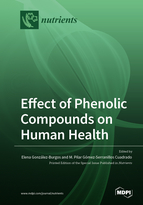Effect of Phenolic Compounds on Human Health
A special issue of Nutrients (ISSN 2072-6643). This special issue belongs to the section "Phytochemicals and Human Health".
Deadline for manuscript submissions: closed (31 May 2021) | Viewed by 80726
Special Issue Editors
Interests: natural products; health; pharmacology; phenolic compounds
Special Issues, Collections and Topics in MDPI journals
Interests: natural products; health; pharmacology; phenolic compounds
Special Issues, Collections and Topics in MDPI journals
Special Issue Information
Dear Colleagues,
Phenolic compounds are non-essential dietary compounds that are found in many vegetables, fruits, cereals and beverages. Structurally, these compounds are characterized by comprising an aromatic ring with one or more hydroxyl groups that can be classified into two groups: flavonoids and non-flavonoids. Phenolic compounds have received considerable attention for its health-promoting properties in many chronic disorders including diabetes, cardiovascular diseases, cancer and neurodegenerative diseases, among others. These health benefits are mainly attributed to its antioxidant properties. Phenolic compounds act as antioxidant by scavenging free radicals, metal chelation and endogenous antioxidant system upregulation.
The consumption of exogenous medicinal plants and food rich in phenolic compounds represent a proinsing therapeutically to prevent many chronic diseases and improve health.
This Special Issue of Nutrients entitled “Effect of Phenolic Compounds on Human Health” welcomes the submission of research articles, review articles, systematic reviews and meta-analysis and short communications.
Dr. Elena Gonzalez-Burgos
Prof. M. Pilar Gómez-Serranillos Cuadrado
Guest Editors
Manuscript Submission Information
Manuscripts should be submitted online at www.mdpi.com by registering and logging in to this website. Once you are registered, click here to go to the submission form. Manuscripts can be submitted until the deadline. All submissions that pass pre-check are peer-reviewed. Accepted papers will be published continuously in the journal (as soon as accepted) and will be listed together on the special issue website. Research articles, review articles as well as short communications are invited. For planned papers, a title and short abstract (about 100 words) can be sent to the Editorial Office for announcement on this website.
Submitted manuscripts should not have been published previously, nor be under consideration for publication elsewhere (except conference proceedings papers). All manuscripts are thoroughly refereed through a single-blind peer-review process. A guide for authors and other relevant information for submission of manuscripts is available on the Instructions for Authors page. Nutrients is an international peer-reviewed open access semimonthly journal published by MDPI.
Please visit the Instructions for Authors page before submitting a manuscript. The Article Processing Charge (APC) for publication in this open access journal is 2900 CHF (Swiss Francs). Submitted papers should be well formatted and use good English. Authors may use MDPI's English editing service prior to publication or during author revisions.
Keywords
- Phenolic compounds
- Human health
- Chronic disorders
- Antioxidants







